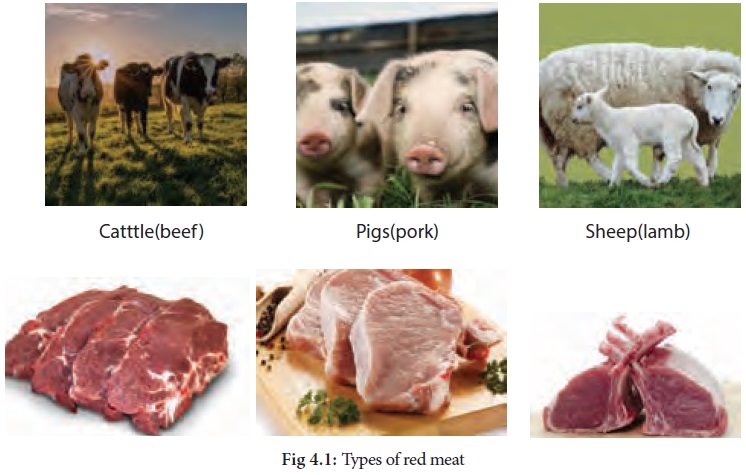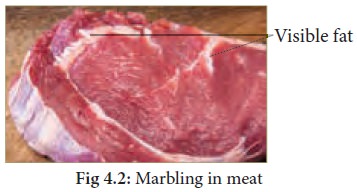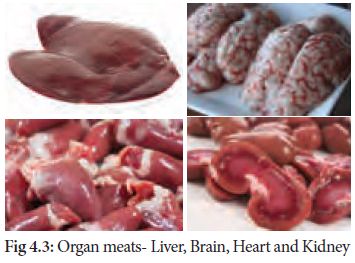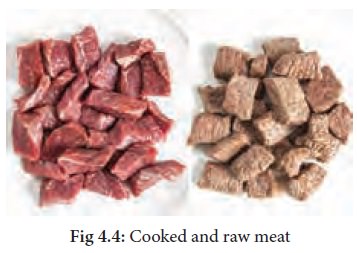Classes, Structure, colour, Composition and Nutritive value - Meat | 11th Nutrition and Dietetics : Chapter 4 : Flesh Foods, Milk and Milk Products
Chapter: 11th Nutrition and Dietetics : Chapter 4 : Flesh Foods, Milk and Milk Products
Meat
FLESH FOODS, MILK AND MILK PRODUCTS
Flesh foods are
consumed since prehistoric times. Meat, poultry and fish are known as flesh
foods. Flesh foods like meat, poultry, pork and fish provide the body with
essential nutrients, minerals and vitamins for it to remain healthy. These foods
contain good quality proteins with high biological value. Egg, milk and milk
products are also good sources of animal proteins providing the body with
essential amino acids which help to promote growth and maintenance of the human
body.
Meat
Meat refers to muscle of
warm blooded four-legged animals. Meat is defined as skeletal muscle with
naturally attached tissue. Red meat consists of mutton, pork, beef and rabbit
meat (Fig.4.1). The flesh of birds (poultry), fish, crustaceans, flesh of
salmon and lobsters are light coloured and are referred to as white meat.

Classes of meat and related products
1. Veal: It is the meat from
cattle slaughtered 3 to 4 weeks after birth.
2. Beef: Meat of cattle over 1
year old.
3. Mutton:
Flesh
of
young ovine animals of
both sexes whose age is 12 months or under.
4. Yearling Mutton: Carcasses of young
sheep usually from 12 to about 20 months old are termed yearling mutton.
5. Mature mutton: Flesh of both the male
and female of ovine species that are 20 months in age at the time of slaughter.
6. Pork: It is the meat of
swine. Good quality pork is obtained from animals between the age of 3-12
months before the amount of fat becomes excessive.
7. Organ meats: Liver, kidney, heart,
thymus, pancreas and brain.
8. Sausages: Made of ground or minced meat and are enclosed in casings
Structure of meat
Animal flesh consists
of muscle tissue or fibres, connective tissue and fatty (adipose) tissue. Lean
meat is the muscle tissue of animals.
Meat muscle is made up
of bundles of muscle fibres held together by creamy white connective tissues.
Tendons join muscles (made up of bundles of muscle fibres, surrounded by
connective tissue) to the bones of animals.
Fat: Fat is distributed
throughout meat in small particles or in large masses. The pattern formed by
the uniform distribution of fat in small “lakes” throughout the muscle or lean
flesh is called marbling and is considered an important factor in contributing
tenderness and flavour to muscle tissue
The colour of meat
The colour of meat is due to the red pigment called myoglobin.

Offals (Organ meats)
Offal also called as
organ meats, refers to the internal organs and entrails of a butchered animal.
The name offal means “off fall”, in other words, the bits which fall from an
animal when it is butchered. The term offals generally covers organs such as
the heart, liver and lungs (collectively known as the pluck) and other organs
like the kidneys, brains, head, feet, tongue, intestines and tails. Offal from
birds is generally referred to as giblets.
Offals are a highly
nutritious food and an excellent source of protein. The liver, kidney and heart
are a good source of iron and vitamins A, and D.


Composition and Nutritive value of meat
Meat has an
outstanding nutritive value, contributing substantial amount of high quality
proteins and essential minerals and vitamins to the diet. Meat contains 15- 20
percent protein of high biological value. The proteins of meat are well
utilized by the body, thus ensuring a supply of essential amino acids necessary
for growth and maintenance. Meat contains enough iron, phosphorus, zinc and
copper to rate as an important source of these minerals.
As
farasvitaminsareconcerned, vitamin A, thiamine and riboflavin are present in
liver, kidneys, heart and sweetbreads (the pancreas or the thymus). All lean
meats contain thiamine, riboflavin and niacin. Meat is also relatively high in
energy value. Meat fats are rich in saturated fatty acids.
Post mortem changes in meat
The changes taking
place in meat after slaughter may be grouped under two heads:
a. Onset of rigor mortis
b. Development
of
tenderness
in muscles
a. Onset of rigor mortis:
After slaughtering,
the lean tissues undergo a series of complex physical and chemical changes. As
a result, muscles lose their soft pliable nature and become rigid, stiff and
inflexible. This is termed as “rigor mortis”.
Stiff muscle starts to
soften and becomes tender when it is held in a cold room temperature between
0°C to 20°C for 1–4 weeks. This is known as “ripening” or “ageing”. During
ageing the humidity of the room is to be controlled.
b. Development of tenderness:
Meat can be made
tender by using mechanical methods like pounding, cutting and grinding which
break muscle fibre. Addition of salt, vinegar, lime juice and enzymes like
papain (raw papaya), bromelin (pineapple) and ficin (figs) also help in
tenderizing meat.
Meat Cookery
Intheprocessofcooking,
manychemical changes occur affecting the appearance, taste and texture of meat.
Cooking meat-

· Develops or improve flavour, colour, aroma.
·
Makes it delicious and appetizing to eat.
·
Makes it more tender.
·
Makes it easier to digest.
·
Makes it safe to eat - kill any harmful bacteria it may have
picked up during handling.
Changes that occur during cooking:
On cooking, the red
pigment of meat turns brown due to the denaturation of protein pigment.
Cooking (heat
treatment) also brings about inactivation of enzymes and denaturation of
proteins, which makes the meat tougher
When meat is cooked
volatile compounds from both fat and lean meat are released which contributes
to the flavour and taste of cooked meat.
Cooking melts the meat
fat which increases palatability of meat when eaten warm.
There is loss of water
on cooking meat which does not change the nutritive value but may affect the
juiciness and bring about shrinkage in volume and weight.
Related Topics